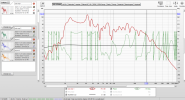Hello guys, i have made some progress with my subs but i could do with some advice.
I went ahead and bought an Aiyima A07 max, the new version of the Aiyima A07 that has mono mode and bypassed the plate amp of the SVS soldering the driver cables directly to the high level inputs of the sub. Then i can use the sub as if it was passive leaving the plate in place but unplugged:
View attachment 328299 View attachment 328300 View attachment 328303
Et voilà, the rumble is completely gone and, to my ears, it sounds fantastic! Easiest and most satisfying mod ever!
As i have two identical SVS SB1000, i took the chance to measure the modded one vs the stock one:
Regarding SPL, my UMIK reports that the stock sub can reach 105 dB at max vol (with REW pink noise) and with the Aiyima at max vol in exact same conditions it reaches 110 dB, so no issues there. Man, the little aiyima literally dances on top of the sub when maxed!
Now, of course, i am bypassing as well whatever DSP the SVS has built in. Reading the datasheet of the DSP chip i had the impression that there was nothing complex going on, probably only the volume control and low and high pass filter. But to check it out I measured some sweeps with REW and i can see some differences. I don't know how relevant (good or bad) these differences can be so i am posting the measurements seeking for advice.
Here is the full sweeps. There is no EQ at all, I just adjusted the volume of both the aiyima and the stock plate amp. I took two measurements of each just in case. Both subs were measured exactly in the same position with the mic also in the same position:
View attachment 328312
the SVS is set with the xover frequency at its max value, obviously the aiyima plays full range. Other than that, the only differences i see is the boost between 20-40 Hz in the SVS and a lower response between 45 and 90 Hz. Both filters have a strong influence in the distorsion:
SVS: the boost at 20-40 comes with a boost on distortion:
View attachment 328314
Aiyima: much less distortion at 20-40 but significantly more at 45-90:
View attachment 328316
finally phase. I dont know how to read this so i just leave it there. They look quite different. Comments are welcome.
SVS:
View attachment 328319
aiyima:
View attachment 328318
what do you think? there is no way i revert the mod and go back to the stupid rumble, but will i be missing something?
(of course, i will be applying proper low pass filter at 100 Hz - mains are kef LS50 meta - and room eq)

